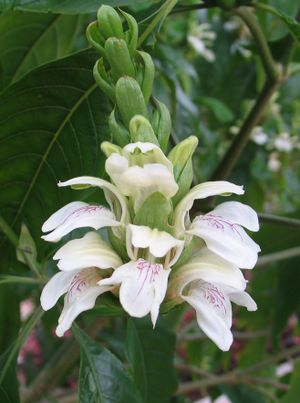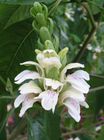Note: This is a project under development. The articles on this wiki are just being initiated and broadly incomplete. You can Help creating new pages.
Difference between revisions of "Justicia adhatoda - Simhaparni"
(→Commonly seen growing in areas) |
|||
| (31 intermediate revisions by 3 users not shown) | |||
| Line 1: | Line 1: | ||
[[File:Justicia adhatoda 1.jpg|thumb|right|'''Malabar Nut''']] | [[File:Justicia adhatoda 1.jpg|thumb|right|'''Malabar Nut''']] | ||
| − | '''Simhaparni''' is sanskrit name of ''' | + | '''Simhaparni''' is the sanskrit name of '''Justicia adhatoda'''. It is native to Asia, widely used in Siddha Medicine, Ayurveda, homeopathy and Unani systems of medicine. The plant's range includes Sri Lanka, Nepal, India, Pakistan, Indonesia, Malaysia, and China as well as Panama where it is thought to have been introduced. |
| − | |||
==Uses== | ==Uses== | ||
| − | {{Uses|Joint | + | {{Uses|Joint pain}}, {{Uses|Cuts}}, {{Uses|Cough}}, {{Uses|Skin itchiness}}, {{Uses|Respiratory disorders}}, {{Uses|Asthma}}, {{Uses|Abnormal bleeding}}, {{Uses|Peptic ulcers}}, {{Uses|Piles}}.<ref name="Uses"/> |
==Parts Used== | ==Parts Used== | ||
| − | {{Parts Used| | + | {{Parts Used|Roots}}, {{Parts Used|Leaves}}, {{Parts Used|Stem}}, {{Parts Used|Flowers}}. |
==Chemical Composition== | ==Chemical Composition== | ||
| − | + | Adhatoda zeylanica contains a number of chemical constituents which are responsible to cure many diseases and disorders.<ref name="chemical composition"/> | |
==Common names== | ==Common names== | ||
| − | {{Common names|kn=Aadu muttada gida, Aadu soge|ml=Adel-odagam | + | {{Common names|kn=Aadu muttada gida, Aadu soge ಅಡುಸೋಗೆ|ml=Adel-odagam|sa=Arus, Vajidantakahaatarusha|ta=Aadaathodai, Acalai|te=Addasaramu, Addasarapaku|hi=Adusa, Vasak|en=Malabar nut|mr=Adulasa}}<ref name="Common names"/> |
==Properties== | ==Properties== | ||
| Line 35: | Line 34: | ||
==Identification== | ==Identification== | ||
===Leaf=== | ===Leaf=== | ||
| − | {{Leaf|Simple|10-30 cm long | + | {{Leaf|Simple, Opposite|Lanceolate to ovate-lanceolate|Leaves 10 - 30 cm long, slightly acuminate, base tapering, petiolate, petioles 1 - 2.5 cm long.}}<ref name="Leaf"/> |
===Flower=== | ===Flower=== | ||
| − | {{Flower|Unisexual|2-4cm long| | + | {{Flower|Unisexual|2-4cm long|White|2|Axillary pedunculate spikes, the corolla is large and white with a funnel shaped lower portion, Flowering season: July-September}} |
===Fruit=== | ===Fruit=== | ||
| − | {{Fruit| | + | {{Fruit|Capsule|1.9-2.2 x 0.8 cm wide||The fruit is a small capsule|Many|Fruiting season: July-September}} |
===Other features=== | ===Other features=== | ||
==List of Ayurvedic medicine in which the herb is used== | ==List of Ayurvedic medicine in which the herb is used== | ||
| − | * [[ | + | * [[Vasarishta]] |
| + | * [[Mathala rasayanam]] | ||
| + | * [[Maha Vishagarbha taila]] | ||
| + | <ref name="Ayurvedic preparations"/> | ||
==Where to get the saplings== | ==Where to get the saplings== | ||
| Line 56: | Line 58: | ||
==Commonly seen growing in areas== | ==Commonly seen growing in areas== | ||
| − | {{Commonly seen| | + | {{Commonly seen|Himalayas}}, {{Commonly seen|Tropical area}}, {{Commonly seen|At cold forest}}. |
==Photo Gallery== | ==Photo Gallery== | ||
| Line 62: | Line 64: | ||
File:Justicia adhatoda 1.jpg | File:Justicia adhatoda 1.jpg | ||
File:Justicia adhatoda (537093805).jpg | File:Justicia adhatoda (537093805).jpg | ||
| − | |||
File:Zey3.jpg | File:Zey3.jpg | ||
File:Zey2.jpg | File:Zey2.jpg | ||
| Line 71: | Line 72: | ||
<references> | <references> | ||
| − | <ref name="chemical composition">[http://www.researchjournal.co.in/upload/assignments/4_304-306.pdf | + | <ref name="chemical composition">[http://www.researchjournal.co.in/upload/assignments/4_304-306.pdf Chemical constituents]</ref> |
| − | <ref name="Leaf">[https://www.bimbima.com/ayurveda/vasa-malabar-nut-benefits-medicinal-uses-and-side-effects/915/ | + | <ref name="Leaf">[https://www.bimbima.com/ayurveda/vasa-malabar-nut-benefits-medicinal-uses-and-side-effects/915/ General Information]</ref> |
| − | <ref name="How to plant/cultivate">[http://tropical.theferns.info/viewtropical.php?id=Justicia+adhatoda | + | <ref name="How to plant/cultivate">[http://tropical.theferns.info/viewtropical.php?id=Justicia+adhatoda Cultivation Details]</ref> |
| + | <ref name="Ayurvedic preparations">[https://easyayurveda.com/2014/07/25/vasaka-adhatoda-vasica-uses-side-effects-research/ Ayurvedic preparations]</ref> | ||
| + | <ref name="Common names">Karnataka Aushadhiya Sasyagalu By Dr.Maagadi R Gurudeva, Page no:33</ref> | ||
| + | <ref name="Uses">Kappathagudda - A Repertoire of Medicinal Plants of Gadag, Page no: 42</ref> | ||
| + | |||
</references> | </references> | ||
| Line 83: | Line 88: | ||
[[Category:Herbs]] | [[Category:Herbs]] | ||
| + | [[Category:Ayurvedic herbs that don't have seed photos]] | ||
| + | [[Category:Acanthaceae]] | ||
Latest revision as of 17:25, 26 January 2021
Simhaparni is the sanskrit name of Justicia adhatoda. It is native to Asia, widely used in Siddha Medicine, Ayurveda, homeopathy and Unani systems of medicine. The plant's range includes Sri Lanka, Nepal, India, Pakistan, Indonesia, Malaysia, and China as well as Panama where it is thought to have been introduced.
Contents
- 1 Uses
- 2 Parts Used
- 3 Chemical Composition
- 4 Common names
- 5 Properties
- 6 Habit
- 7 Identification
- 8 List of Ayurvedic medicine in which the herb is used
- 9 Where to get the saplings
- 10 Mode of Propagation
- 11 How to plant/cultivate
- 12 Commonly seen growing in areas
- 13 Photo Gallery
- 14 References
- 15 External Links
Uses
Joint pain, Cuts, Cough, Skin itchiness, Respiratory disorders, Asthma, Abnormal bleeding, Peptic ulcers, Piles.[1]
Parts Used
Chemical Composition
Adhatoda zeylanica contains a number of chemical constituents which are responsible to cure many diseases and disorders.[2]
Common names
| Language | Common name |
|---|---|
| Kannada | Aadu muttada gida, Aadu soge ಅಡುಸೋಗೆ |
| Hindi | Adusa, Vasak |
| Malayalam | Adel-odagam |
| Tamil | Aadaathodai, Acalai |
| Telugu | Addasaramu, Addasarapaku |
| Marathi | Adulasa |
| Gujarathi | NA |
| Punjabi | NA |
| Kashmiri | NA |
| Sanskrit | Arus, Vajidantakahaatarusha |
| English | Malabar nut |
Properties
Reference: Dravya - Substance, Rasa - Taste, Guna - Qualities, Veerya - Potency, Vipaka - Post-digesion effect, Karma - Pharmacological activity, Prabhava - Therepeutics.
Dravya
Rasa
Tikta (Bitter), Kashaya (Astringent)
Guna
Laghu (Light), Ruksha (Dry)
Veerya
Sheeta (Cold)
Vipaka
Katu (Pungent)
Karma
Kapha, Pitta
Prabhava
Habit
Identification
Leaf
| Kind | Shape | Feature |
|---|---|---|
| Simple, Opposite | Lanceolate to ovate-lanceolate | Leaves 10 - 30 cm long, slightly acuminate, base tapering, petiolate, petioles 1 - 2.5 cm long. |
Flower
| Type | Size | Color and composition | Stamen | More information |
|---|---|---|---|---|
| Unisexual | 2-4cm long | White | 2 | Axillary pedunculate spikes, the corolla is large and white with a funnel shaped lower portion, Flowering season: July-September |
Fruit
| Type | Size | Mass | Appearance | Seeds | More information |
|---|---|---|---|---|---|
| Capsule | 1.9-2.2 x 0.8 cm wide | The fruit is a small capsule | Many | Fruiting season: July-September |
Other features
List of Ayurvedic medicine in which the herb is used
Where to get the saplings
Mode of Propagation
How to plant/cultivate
A plant of the drier to wet, lowland tropics, where it is found at elevations up to 1,300 metres[6]
Commonly seen growing in areas
Himalayas, Tropical area, At cold forest.
Photo Gallery
References
- ↑ Kappathagudda - A Repertoire of Medicinal Plants of Gadag, Page no: 42
- ↑ Chemical constituents
- ↑ Karnataka Aushadhiya Sasyagalu By Dr.Maagadi R Gurudeva, Page no:33
- ↑ General Information
- ↑ Ayurvedic preparations
- ↑ Cultivation Details
External Links
- Ayurvedic Herbs known to be helpful to treat Joint pain
- Ayurvedic Herbs known to be helpful to treat Cuts
- Ayurvedic Herbs known to be helpful to treat Cough
- Ayurvedic Herbs known to be helpful to treat Skin itchiness
- Ayurvedic Herbs known to be helpful to treat Respiratory disorders
- Ayurvedic Herbs known to be helpful to treat Asthma
- Ayurvedic Herbs known to be helpful to treat Abnormal bleeding
- Ayurvedic Herbs known to be helpful to treat Peptic ulcers
- Ayurvedic Herbs known to be helpful to treat Piles
- Herbs with Roots used in medicine
- Herbs with Leaves used in medicine
- Herbs with Stem used in medicine
- Herbs with Flowers used in medicine
- Herbs with common name in Kannada
- Herbs with common name in Hindi
- Herbs with common name in Malayalam
- Herbs with common name in Tamil
- Herbs with common name in Telugu
- Herbs with common name in Marathi
- Herbs with common name in Sanskrit
- Herbs with common name in English
- Habit - Shrub
- Index of Plants which can be propagated by Seeds
- Index of Plants which can be propagated by Cuttings
- Herbs that are commonly seen in the region of Himalayas
- Herbs that are commonly seen in the region of Tropical area
- Herbs that are commonly seen in the region of At cold forest
- Herbs
- Ayurvedic herbs that don't have seed photos
- Acanthaceae





